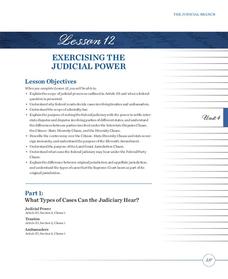Curated OER
Checks on Presidential Power
Students examine presidential powers. For this checks and balances lesson, students identify the constitutional and informal restraints of the president and consider the reasons for the limitations.
Curated OER
The Three Branches of Government (Legislative, Executive, Judicial)
Fifth graders compare the three branches of government to a three-legged chair. In this government lesson, 5th graders discuss the Founding Fathers, the Constitution, and checks and balances. Students study what each branch of government...
Curated OER
The U.S. Constitution Power Grab Game
Students study the powers and limitations of the three branches of the American government. They explain how the system of "checks and balances" protects the individual citizens. They explain how the amendments to the Constitution...
Carolina K-12
Principles of the US Constitution
After breaking into groups according to major principles of government (i.e., popular sovereignty, separation of powers, checks and balances, etc.) in the United States, your class members will produce public service announcements...
Curated OER
The Three Branches of Government
Seventh graders discover details about the responsibilities of the 3 branches of government in the United States. In this checks and balances lesson plan, 7th graders view a SMART Board supported lecture that reveals the jobs of the...
American Constitution Society
Constitution in the Classroom: The Right to Vote
The system of checks and balances is integral to the functionality of the United States government. Learn more about the ways the three branches of the government work together—and about the limitations of their power—with an informative...
Curated OER
U.S. and Iroquois Governments
Eighth graders compare the roles and functions of the different branches of the Iroquois and US governments, and the the principles of separation of power.
Curated OER
Lesson Plan: U.S. Government
Students examine reasons for studying government. For this U.S. government lesson, students brainstorm the reasons for rules. Students draft their own class constitution in the style of the U.S. Constitution.
Curated OER
Separation of Powers
Students compare the role of federal and local government. In this government lesson plan, students watch "Separation of Powers." Students discuss the federal and state powers prior to participating in a simulation that requires them to...
Curated OER
Letters to the Government
Seventh graders examine how to be active participants in their local, state, or federal governments. They create a powerpoint presentation and write a letter to one of their governmental representatives about a problem and solution of...
Curated OER
US Government: The Constitution
Students explore the branches of government. In this U. S. Constitution lesson, students examine the system of checks and balances in the U.S. plan of government as they read the document and define vocabulary words.
Ohio Center For Law-Related Education
Four Activities: Thurgood Marshall and the Nomination and Confirmation of Federal Judges
The process of nominating and confirming federal judges can sound like a lot of bureaucratic hoops, but a resource breaks down the steps of the Supreme Court nominations in a simpler manner. Learners participate in four activities that...
C-SPAN
Presidential Veto and Congressional Override
One of the key powers of the executive branch is the president's ability to pass or veto legislation proposed by Congress. Congress, the legislative branch, on the other hand, can override a president's veto. Five film clips show how the...
Curated OER
The 7 "Hats" of the President
Students explore the responsibilities of the President. In this U.S. government lesson, students examine the provided sources related to the President' s roles as Chief of State, Chief Executive, Chief Jurist, Chief Diplomat, Chief...
Curated OER
Separation of Powers: Checks and Balances
Students discuss the reasons for separation of powers between the branches of government. They list the branches and identify the powers and functions of each.
Curated OER
Government: Balance of Power
Fifth graders conduct Internet research about the governmental balance of power. They create Kidspiration projects demonstrating the workings of the three branches of government. They compare U.S. democracy with other forms of government.
Curated OER
Financial Institution Comparison
Once learners are ready to choose a bank, how do they make a smart decision for their financial needs? Scholars help each other by jigsawing the research in groups. After introducing checking and savings accounts with the attached...
Heritage Foundation
Exercising Judicial Power
We should all do more exercising, but should the judicial branch as well? High schoolers develop their understanding of what powers the judicial branch carries because of the US Constitution, as well as where their limits lie in the...
Curated OER
Balancing Budgets: From Reagan to Today
Students discover details about the federal budget. In this contemporary government lesson, students research the efforts to maintain a balanced federal budget in the United States since the 1980's. Students then participate in a debate...
Curated OER
Government Lesson Plan: Lesson 1
Students identify the powers of national and state governments. They evaluate the balance of national versus state power. They utilize worksheets imbedded in this plan to gain a deeper perspective of how the government powers are separated.
iCivics
Mini-Lesson: Executive Orders
Can the President of the United States pass a law all by himself? Scholars investigate the concept of the executive order in regards to the powers of the presidency. They use current issues and events to monitor media bias while also...
Curated OER
Separation of Powers
Students examine the separation of powers in local and federal government. Using case studies, they review several instances of separation of powers. After reading the case studies, they write a brief opinion essays supporting their...
Curated OER
We the People... How Does Government Secure Natural Rights?
High schoolers investigate the Founders' ideas about what kind of government is most likely to protect the basic rights of people. They distinguish between limited and unlimited government.
Curated OER
The Executive Branch
Students study the federal government, which is divided into 3 branches. They have a minimal understanding of the responsibilities of each branch.

























